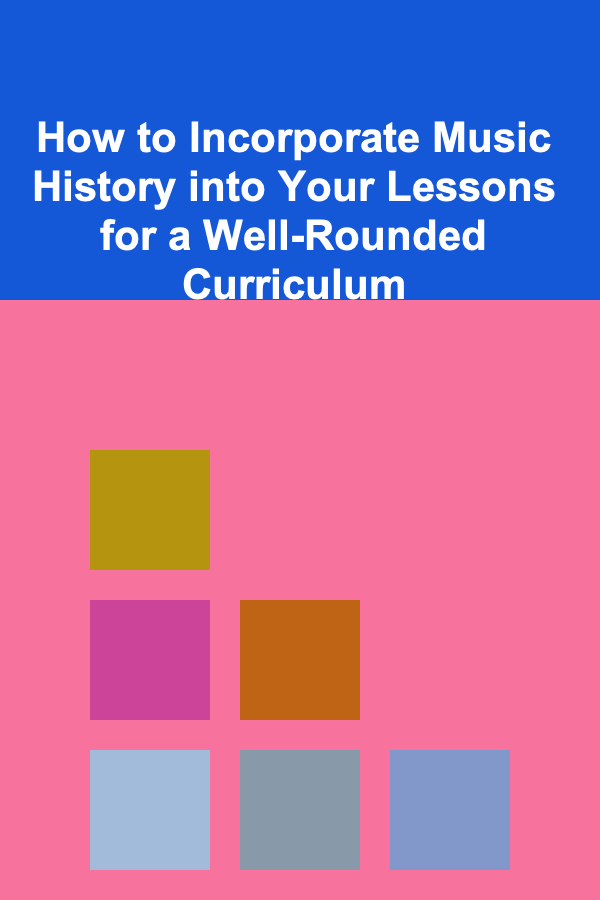
How to Incorporate Music History into Your Lessons for a Well-Rounded Curriculum
ebook include PDF & Audio bundle (Micro Guide)
$12.99$8.99
Limited Time Offer! Order within the next:

Integrating music history into your lessons is one of the most effective ways to provide students with a well-rounded education. Music is not just an art form; it's a reflection of human history, culture, and evolution. By incorporating music history into your curriculum, you not only deepen students' understanding of music itself but also enhance their comprehension of the broader historical, social, and cultural contexts in which music has developed.
Whether you're teaching elementary, high school, or university-level students, there are many ways to incorporate music history that will enrich your curriculum. This guide will explore actionable steps to seamlessly integrate music history into your lessons, providing students with a holistic understanding of music's role in shaping societies and cultures.
Start with the Basics: Why Music History Matters
Before diving into specific eras or genres, it's essential to establish why music history is crucial. Help students understand that music is deeply intertwined with historical events, social movements, and technological advancements.
Actionable Tips:
- Contextualize Music with Major Events: Introduce key historical events---such as the Industrial Revolution, the Civil Rights Movement, or World War II---and explain how they influenced the music of the time. For example, explore how the Civil Rights Movement shaped the development of jazz, blues, and gospel music.
- Discuss Cultural Significance: Discuss how different genres of music reflect the values and struggles of various societies. For instance, folk music often reflects the hardships and stories of the common people, while classical music could represent the ideals of aristocracy or intellectualism.
By helping students recognize the connection between music and history, you'll establish a foundation for further exploration.
Integrate Key Music Periods into the Curriculum
Music history spans several periods, each with its distinct characteristics, technological innovations, and cultural influences. From the medieval era to modern popular music, students can explore the evolution of sound, style, and instrumentation.
Actionable Tips:
-
Chronologically Structure Lessons: Organize lessons to align with major historical periods. For instance, you can begin with the Medieval Period, exploring Gregorian chants and the development of notation, then move into the Renaissance, Baroque, Classical, Romantic, and 20th Century periods. Each of these periods offers insights into not only musical development but also the philosophical, social, and technological innovations of the time.
For example:
- Medieval Period: Discuss Gregorian chants and the rise of polyphony.
- Baroque Period: Dive into the role of orchestras, the emergence of opera, and composers like Bach and Handel.
- Classical Period: Explore the music of Mozart, Beethoven, and Haydn and the shift towards symphonic music.
- Romantic Period: Examine how music became more emotional, with composers like Chopin and Tchaikovsky embodying individualism.
- 20th Century and Beyond: Discuss jazz, pop, and electronic music as reflections of modern life.
-
Highlight Innovations: Teach students how technological advances, such as the invention of the piano or the development of the phonograph, influenced musical compositions and performance.
Use Music to Illuminate Social and Political Movements
One of the most compelling aspects of music history is its connection to social and political movements. Music has always played a central role in rallying people, communicating social change, and influencing public opinion.
Actionable Tips:
- Focus on Protest Songs: Many music genres---particularly folk, rock, and hip-hop---have roots in protest movements. Introduce students to songs like Bob Dylan's "Blowin' in the Wind" (Civil Rights Movement), or more contemporary protest songs such as those by Kendrick Lamar or Green Day. Discuss how these songs reflect the political climates of their time.
- Explore Music in War Time: The role of music during wartime is also an essential part of music history. Explore the military marches of the World Wars, the folk music of the 1960s related to Vietnam, and how music in the U.S. and Europe evolved during and after conflicts.
Linking music to political events gives students insight into how art and culture influence and reflect societal changes.
Incorporate Cross-Disciplinary Lessons
Music history should not exist in a vacuum---it can benefit from cross-disciplinary connections to history, literature, art, and even science. A holistic approach can help students see the broader cultural contexts behind the music they study.
Actionable Tips:
- Combine Music and History: Use music to explore historical events. For example, you could pair the study of World War II with the music of the time, such as the "We Shall Overcome" anthem, or delve into the role of jazz in post-World War II America.
- Literary Connections: Many pieces of music are inspired by literature or poems. Discuss compositions like Tchaikovsky's "Romeo and Juliet" or Mussorgsky's "Pictures at an Exhibition." Explore how these works translate the essence of literature into sound.
- Visual Arts Integration: Discuss the relationship between visual art movements (like Impressionism or Cubism) and music of the same time period. Composers such as Claude Debussy, who was influenced by Impressionism, can be examined alongside the work of painters like Monet or Renoir.
Cross-disciplinary lessons allow students to view music as part of a larger cultural landscape, deepening their understanding.
Use Listening and Analysis to Deepen Historical Understanding
Listening to music is one of the most powerful ways for students to engage with music history. However, it's not enough to simply play a song; students need to be encouraged to listen actively and analyze the music within its historical context.
Actionable Tips:
- Introduce Musical Analysis: Teach students how to analyze music within the framework of its historical period. For example, when listening to a Baroque piece, focus on the characteristics of the music, such as ornamentation, counterpoint, and the basso continuo.
- Contextual Listening: Pair pieces of music with information about the time period or composer. For example, when studying Beethoven's Symphony No. 5, discuss how it reflects the cultural and philosophical changes of the Enlightenment era and the rise of individualism.
- Create Listening Exercises: Have students listen to different genres and periods and identify the elements that distinguish them. For instance, they could listen to a Gregorian chant and a modern pop song and compare how rhythm, melody, and instrumentation differ based on the time period.
Listening and analysis transform music history from abstract information into an immersive experience that students can feel and understand on a deeper level.
Introduce Diverse Musical Traditions
When teaching music history, it's essential to incorporate music from various cultures and countries. This promotes an understanding of music as a global phenomenon, expanding students' horizons and fostering appreciation for diverse musical traditions.
Actionable Tips:
- Explore Non-Western Music: While Western classical music is often emphasized, don't neglect other musical traditions. Introduce students to Indian classical music, African drumming, Chinese opera, or Latin American folk music. Discuss how these traditions evolved in their respective cultures and how they interact with the music of the West.
- Cultural Contexts: For example, explore how the rhythms of African music influenced jazz in America or how Caribbean music impacted the development of reggae. This helps students understand music history as a melting pot of global influences.
By including diverse musical traditions, you broaden your students' perspectives on the world and emphasize music's universal importance.
Foster Interactive Learning and Critical Thinking
Rather than merely delivering content, encourage students to actively participate in their learning. Encourage them to ask questions, conduct research, and even create music projects that reflect their understanding of historical music movements.
Actionable Tips:
- Encourage Research Projects: Have students research a particular composer, era, or music movement and present their findings to the class. This promotes critical thinking and allows them to take ownership of their learning.
- Create Collaborative Projects: Encourage students to collaborate on projects where they perform, compose, or produce music that reflects a specific historical period or social movement.
- Debate Musical Impact: Hold debates where students argue the significance of a particular musical period, composer, or genre. This enhances their ability to think critically about the impact of music on society.
Interactive learning helps students develop a deeper understanding of music history while engaging their creativity and critical thinking skills.
Conclusion
Incorporating music history into your lessons is a powerful way to create a well-rounded curriculum. By integrating historical contexts, social movements, cross-disciplinary lessons, and diverse musical traditions, you provide students with a richer, more comprehensive understanding of music's place in society. By listening critically, exploring the broader cultural landscape, and fostering interactive learning, students not only learn about music history but also develop essential skills for understanding the world around them.
Reading More From Our Other Websites
- [Organization Tip 101] How to Organize Your Media Collection
- [Biking 101] The Ultimate Guide to Cycling Injuries: Prevention, Recovery, and Rehabilitation
- [Personal Care Tips 101] How to Choose Mouthwash That Works with Your Toothpaste
- [Home Cleaning 101] How to Use Vinegar as a Powerful Cleaning Agent
- [Home Cleaning 101] How to Clean Your Oven Without Harsh Chemicals
- [Stamp Making Tip 101] Creative Playtime: 5 Simple Stamp-Making Projects for Little Artists
- [Metal Stamping Tip 101] Best Metal Stamping Techniques for Creating Stunning Personalized Gifts
- [Organization Tip 101] How to Use Seasonal Changes to Reorganize Pet Supplies
- [Home Budget 101] How to Use Cash-Back Apps to Save on Home Expenses
- [Home Maintenance 101] How to Winterize Your Home to Save Energy

How to Create a Home Budget That Works for You
Read More
How to Master the Perfect Squat
Read More
How to Streamline Check-In Processes for Guests
Read More
Passive Income Opportunities with Deep Learning
Read More
How to Discover Novels That Are Perfect for Escaping Reality
Read More
10 Tips for Protecting Your Eyes from Sun Damage
Read MoreOther Products

How to Create a Home Budget That Works for You
Read More
How to Master the Perfect Squat
Read More
How to Streamline Check-In Processes for Guests
Read More
Passive Income Opportunities with Deep Learning
Read More
How to Discover Novels That Are Perfect for Escaping Reality
Read More